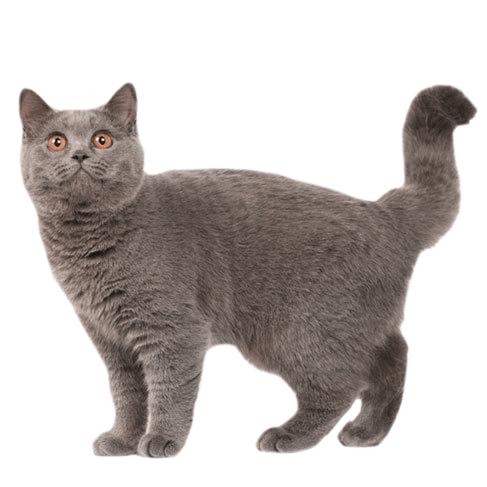

An intelligent and gentle breed, great for families
British Shorthairs are well known for their round face and eyes, giving them a butter-wouldn’t-melt innocent look - but don’t be deceived! This gorgeous breed has oodles of character and isn’t nearly as demure as their doe-eyed expression suggests.
Vital Stats
| Size: | Medium to large |
|---|---|
| Coat: | Short and dense |
| Life span: | 8 – 12 years |
| Personality: | Gentle, affectionate, independent |
coat Life span 8-12years
British Shorthair Personality & Temperament
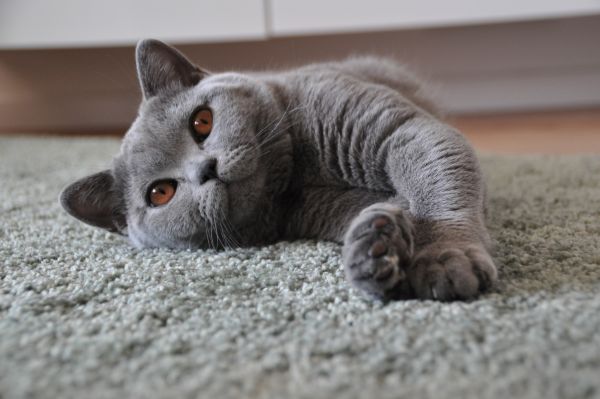
Friendly and chilled, British Shorthairs are a great companion for homes with or without children.
- The British Shorthair cat personality combines the best of cat personalities; when they are well socialised as young kittens they are friendly and affectionate, but also independent and content.
- Happy in their own company, British Shorthair cats will let you know when they want to play, often bringing their own cat toys along to make a point. While they’re not the chattiest of cats, their voices tend to be a bit lower and they’ll only vocalise when they really want your attention.
- The prey drive is extremely strong in a British Shorthair, so don’t be too surprised if your furry friend brings you regular “treats” that they’ve caught themselves. This can be a bit of a shock, especially for a first time cat owner, if you weren’t expecting this from your sweet-tempered cuddly companion.
- British Shorthair cats love to cuddle and play, but aren’t demanding of their human companions. They make lovely additions to a family with or without children due to their gentle nature.
- They love short bursts of high-energy play when they’re in the mood, but otherwise enjoy dozing somewhere comfortable. Always ensure that play time with children or other pets is supervised to make sure everyone is safe and happy.
- Despite being very intelligent, this gentle breed is well suited to a calm, quiet life.

British Shorthair Personality & Temperament
Friendly and chilled, British Shorthairs are a great companion for homes with or without children.
- The British Shorthair cat personality combines the best of cat personalities; when they are well socialised as young kittens they are friendly and affectionate, but also independent and content.
- Happy in their own company, British Shorthair cats will let you know when they want to play, often bringing their own cat toys along to make a point. While they’re not the chattiest of cats, their voices tend to be a bit lower and they’ll only vocalise when they really want your attention.
- The prey drive is extremely strong in a British Shorthair, so don’t be too surprised if your furry friend brings you regular “treats” that they’ve caught themselves. This can be a bit of a shock, especially for a first time cat owner, if you weren’t expecting this from your sweet-tempered cuddly companion.
- British Shorthair cats love to cuddle and play, but aren’t demanding of their human companions. They make lovely additions to a family with or without children due to their gentle nature.
- They love short bursts of high-energy play when they’re in the mood, but otherwise enjoy dozing somewhere comfortable. Always ensure that play time with children or other pets is supervised to make sure everyone is safe and happy.
- Despite being very intelligent, this gentle breed is well suited to a calm, quiet life.
Food & Diet
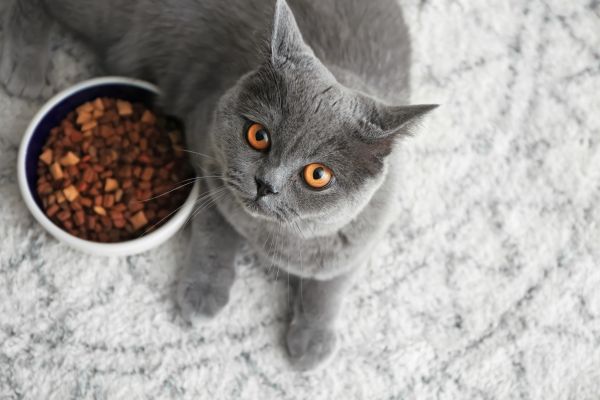
Your British Shorthair will thrive on a high-protein diet but may get bored of the same old cat food quickly!
- The diet of any cat must be appropriate for their age and life-stage; British Shorthairs thrive on a healthy diet of any complete meat-based cat food.
- Like other cats, your British Shorthair’s cat food needs will change as they grow, so bear this in mind and ask your vet’s advice about age-appropriate wet cat food.
- British Shorthairs are more likely to get the protein levels they need from wet cat foods but you may want to supplement their meals with a dry alternative for variety. Again, your vet will be able to advise you on this.
- British Shorthair cats have a tendency to put on weight, so regular, measured meals and plenty of stimulating play are essential.
- As with all cats, it’s important to provide plenty of fresh water.

Food & Diet
Your British Shorthair will thrive on a high-protein diet but may get bored of the same old cat food quickly!
- The diet of any cat must be appropriate for their age and life-stage; British Shorthairs thrive on a healthy diet of any complete meat-based cat food.
- Like other cats, your British Shorthair’s cat food needs will change as they grow, so bear this in mind and ask your vet’s advice about age-appropriate wet cat food.
- British Shorthairs are more likely to get the protein levels they need from wet cat foods but you may want to supplement their meals with a dry alternative for variety. Again, your vet will be able to advise you on this.
- British Shorthair cats have a tendency to put on weight, so regular, measured meals and plenty of stimulating play are essential.
- As with all cats, it’s important to provide plenty of fresh water.
British Shorthair Grooming & Coat Care
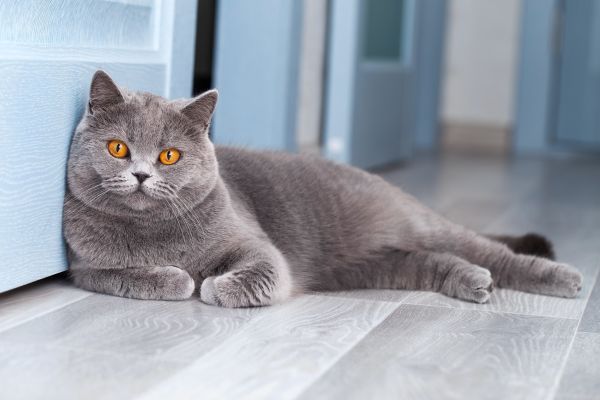
British Shorthairs’ short, dense coat is relatively low maintenance, but they may need extra upkeep in heavy shedding seasons.
- British Shorthair coats come in a variety of gorgeous colours - from sandy blonde to silver tabby, and even an unusual chocolate brown. The most widely recognised colour, though, is British Blue - but not the kind of blue you’re thinking! The blue coats are a charcoal grey with undertones of blue, a rich colour that makes their amber eyes truly attention grabbing.
- The chunky build and short, dense coat of British Shorthair cats makes them stand out against the usually sleek and slender shapes of other breeds like Bengals and Egyptian Mau’s. They are among the easiest of the cat coats to groom, with regular brushing to keep them in top condition with minimal fuss.
- Look out for times when your British Shorthair cat might need extra help with coat care, such as shedding in the springtime.
- Gently introduce grooming to your cat when they are a young kitten, and get them gradually used to regular grooming. Positive reinforcement techniques are great for helping your cat to engage in cooperative care, such as grooming.
- Regular grooming is not only great for bonding, but enables you to see any irregular lumps, bumps, bites and scratches that are best caught early.

British Shorthair Grooming & Coat Care
British Shorthairs’ short, dense coat is relatively low maintenance, but they may need extra upkeep in heavy shedding seasons.
- British Shorthair coats come in a variety of gorgeous colours - from sandy blonde to silver tabby, and even an unusual chocolate brown. The most widely recognised colour, though, is British Blue - but not the kind of blue you’re thinking! The blue coats are a charcoal grey with undertones of blue, a rich colour that makes their amber eyes truly attention grabbing.
- The chunky build and short, dense coat of British Shorthair cats makes them stand out against the usually sleek and slender shapes of other breeds like Bengals and Egyptian Mau’s. They are among the easiest of the cat coats to groom, with regular brushing to keep them in top condition with minimal fuss.
- Look out for times when your British Shorthair cat might need extra help with coat care, such as shedding in the springtime.
- Gently introduce grooming to your cat when they are a young kitten, and get them gradually used to regular grooming. Positive reinforcement techniques are great for helping your cat to engage in cooperative care, such as grooming.
- Regular grooming is not only great for bonding, but enables you to see any irregular lumps, bumps, bites and scratches that are best caught early.
British Shorthair Training & Behaviour
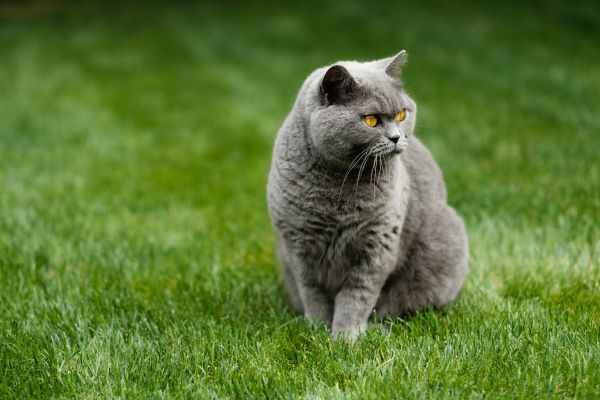
The British Shorthair is a rewarding family pet when it comes to training but they’ll need lots of play and stimulation to prevent boredom.
- A fun-loving breed with a strong sense of independence, the British Shorthair is a rewarding family pet. For households with a lack of, or minimal, outdoor space, British Shorthairs can potentially adapt to indoor-only lifestyles, as long as owners provide opportunities for play and stimulation to prevent boredom.
- British Shorthair cats are very smart and enjoy encouragement and, as such, they are perfect students for training, as well as mastering all manner of fun tricks.
- Clicker training works well for the British Shorthair cat, as does training with treats - but watch out for overindulging as too many treats could cause unhealthy weight gain. Cat toys are a favourite with this playful breed – keep a whole range on hand and rotate them regularly to keep your cat engaged.
- Thanks to their high prey drive, any games that emulate the hunt will be ideal for your new cat. They love to chase and pounce, therefore using cat toys that provide the opportunity for pouncing can be a great way to interact with your British Shorthair cat.
- British Shorthairs will love pouncing on a laser, but make sure that they have something to physically “catch” when playtime’s over to avoid them becoming frustrated.

British Shorthair Training & Behaviour
The British Shorthair is a rewarding family pet when it comes to training but they’ll need lots of play and stimulation to prevent boredom.
- A fun-loving breed with a strong sense of independence, the British Shorthair is a rewarding family pet. For households with a lack of, or minimal, outdoor space, British Shorthairs can potentially adapt to indoor-only lifestyles, as long as owners provide opportunities for play and stimulation to prevent boredom.
- British Shorthair cats are very smart and enjoy encouragement and, as such, they are perfect students for training, as well as mastering all manner of fun tricks.
- Clicker training works well for the British Shorthair cat, as does training with treats - but watch out for overindulging as too many treats could cause unhealthy weight gain. Cat toys are a favourite with this playful breed – keep a whole range on hand and rotate them regularly to keep your cat engaged.
- Thanks to their high prey drive, any games that emulate the hunt will be ideal for your new cat. They love to chase and pounce, therefore using cat toys that provide the opportunity for pouncing can be a great way to interact with your British Shorthair cat.
- British Shorthairs will love pouncing on a laser, but make sure that they have something to physically “catch” when playtime’s over to avoid them becoming frustrated.
What to know before you buy or rehome an British Shorthair cat
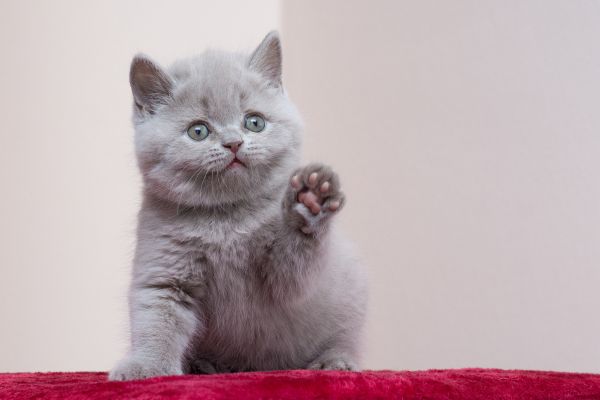
Considering welcoming a fun-loving British Shorthair into your home? Here are the top things to remember:
- British Shorthair cats are a great all-rounder cat for any household. Friendly but undemanding, they can get along with children and other cats as long as they’ve been well socialised as young kittens, carefully matched and gradually introduced. As with all cats, it depends on the individuals involved.
- Be wary of the British Shorthair’s high prey-drive though, as this could cause distress to other smaller pets in your household, as your cat may want to bring their prey back to their ‘territory’.
- They can be chunky, but with care shouldn’t be overweight. British Shorthairs are big food lovers which, coupled with their sleeping habits, means they put on weight easily. Check with your vet regarding the recommended weight and body condition score for your cat’s size to avoid unwanted health issues.
- British Shorthair cats thrive on plenty of space to play in and lots of energetic interaction and games.
- Due to their thick coat, you may want to do some research into the best grooming brushes for British Shorthair cats. Grooming kits and tips can be found online. Regular brushing helps them to shed any dead fur, which will help prevent lots of hair around your home!

What to know before you buy or rehome an British Shorthair cat
Considering welcoming a fun-loving British Shorthair into your home? Here are the top things to remember:
- British Shorthair cats are a great all-rounder cat for any household. Friendly but undemanding, they can get along with children and other cats as long as they’ve been well socialised as young kittens, carefully matched and gradually introduced. As with all cats, it depends on the individuals involved.
- Be wary of the British Shorthair’s high prey-drive though, as this could cause distress to other smaller pets in your household, as your cat may want to bring their prey back to their ‘territory’.
- They can be chunky, but with care shouldn’t be overweight. British Shorthairs are big food lovers which, coupled with their sleeping habits, means they put on weight easily. Check with your vet regarding the recommended weight and body condition score for your cat’s size to avoid unwanted health issues.
- British Shorthair cats thrive on plenty of space to play in and lots of energetic interaction and games.
- Due to their thick coat, you may want to do some research into the best grooming brushes for British Shorthair cats. Grooming kits and tips can be found online. Regular brushing helps them to shed any dead fur, which will help prevent lots of hair around your home!
FAQs
Are British Shorthairs healthy cats?
Generally, British Shorthairs are a healthy breed. However, they are more prone to certain health issues, like hyperthyroidism and some congenital heart problems. There is also a small chance of kidney disease. While these are not curable, they are manageable with medication and won’t impact your cat’s quality of life. Being aware of these conditions early means you can speak to your vet and check for early signs when going in for check-ups.
Are British Shorthairs large cats?
Male British Shorthair cats are quite a lot bigger than their female counterparts, but even so, beyond kittenhood they are a large, solid housecat. Their fairly short fur adds a lot of chunkiness to their physique, so if you prefer your animals to look a bit like a teddy bear, this is a lovely breed to consider.
Are British Shorthairs good indoor cats?
British Shorthair cats love company and an easy life. Like most cats, some outdoor room-to-roam space will encourage British Shorthair cats to stay active and healthy. If you’re concerned about theft or other risks, you might want to invest in some cat-safe outdoor precautions if you have the space. However, this breed can potentially adapt to indoor-only lifestyles and often prefer to stay indoors, as long as they are provided with opportunities for play and stimulation to prevent boredom.
Do British Shorthair cats get on with children and other pets?
Blessed with an even and friendly temperament, British Shorthair cats’ personalities mean they can play well with other cats and less boisterous dogs if they are well socialised, carefully matched and gradually introduced. They can also be a firm friend to children who can respect their need for some personal space. However, thanks to their prey drive, they are not suited to being around smaller animals such as mice, rabbits and guinea pigs, so you will need to keep them separate.
What’s the history of the British Shorthair breed?
The British Shorthair can trace its ancestors back to the Roman days where it was known as a champion mouser. It was brought to England by the Romans and have been a favourite of cat shows since their beginnings in the 19th century. Their official classification as a breed (after years of selective breeding for their now-iconic features) happened in 1870.
Are British Shorthair cats hypoallergenic?
No, while grooming a British Shorthair is straightforward and easy, these cats shed as much as any cat and as such are not hypoallergenic. (Shorter fur doesn’t mean less shedding, but it may be easier to hoover!)
FAQs
Are British Shorthairs healthy cats?
Generally, British Shorthairs are a healthy breed. However, they are more prone to certain health issues, like hyperthyroidism and some congenital heart problems. There is also a small chance of kidney disease. While these are not curable, they are manageable with medication and won’t impact your cat’s quality of life. Being aware of these conditions early means you can speak to your vet and check for early signs when going in for check-ups.
Are British Shorthairs large cats?
Male British Shorthair cats are quite a lot bigger than their female counterparts, but even so, beyond kittenhood they are a large, solid housecat. Their fairly short fur adds a lot of chunkiness to their physique, so if you prefer your animals to look a bit like a teddy bear, this is a lovely breed to consider.
Are British Shorthairs good indoor cats?
British Shorthair cats love company and an easy life. Like most cats, some outdoor room-to-roam space will encourage British Shorthair cats to stay active and healthy. If you’re concerned about theft or other risks, you might want to invest in some cat-safe outdoor precautions if you have the space. However, this breed can potentially adapt to indoor-only lifestyles and often prefer to stay indoors, as long as they are provided with opportunities for play and stimulation to prevent boredom.
Do British Shorthair cats get on with children and other pets?
Blessed with an even and friendly temperament, British Shorthair cats’ personalities mean they can play well with other cats and less boisterous dogs if they are well socialised, carefully matched and gradually introduced. They can also be a firm friend to children who can respect their need for some personal space. However, thanks to their prey drive, they are not suited to being around smaller animals such as mice, rabbits and guinea pigs, so you will need to keep them separate.
What’s the history of the British Shorthair breed?
The British Shorthair can trace its ancestors back to the Roman days where it was known as a champion mouser. It was brought to England by the Romans and have been a favourite of cat shows since their beginnings in the 19th century. Their official classification as a breed (after years of selective breeding for their now-iconic features) happened in 1870.
Are British Shorthair cats hypoallergenic?
No, while grooming a British Shorthair is straightforward and easy, these cats shed as much as any cat and as such are not hypoallergenic. (Shorter fur doesn’t mean less shedding, but it may be easier to hoover!)
British Shorthair insurance considerations
British Shorthairs sometimes suffer with certain health conditions and may require treatment. Petplan cat insurance offers peace of mind that they will always be protected.